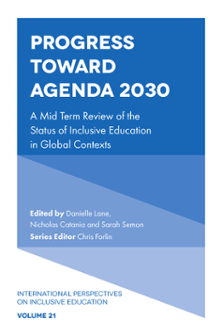In-service teacher training in inclusive education
, 180–181
Inclusion
, 1, 27, 105, 121–122, 173–174, 217–218, 245, 261–262, 264
attitudes of teachers
, 112
barriers to inclusion in Lebanon
, 113–115
in Canada
, 262–264
challenges of inclusion at school level
, 182–184
current state of
, 283–285
elements
, 109–112
experience and training
, 112–113
future of inclusion in Lebanon
, 117–118
history in Lebanon
, 105–107
importance
, 94
international policies related to
, 3–4
in Lebanese schools
, 108–109
legislation and costs of implementing high levels of
, 8–19
levers promoting
, 115–117
policies in England
, 7–8
and relevant institutions
, 107–108
self-efficacy
, 113
of students
, 281–282
students included in general education classrooms
, 284–285
Inclusive digital education, need for
, 53–54
Inclusive education (IE)
, 1, 4–5, 43–44, 59, 106, 121–123, 156–157, 192, 209–210, 261–262, 264, 289, 299
access to education for children in vulnerable situations
, 305
access to education for indigenous peoples
, 304–305
access to education for persons with disabilities
, 303–304
adult and youth literacy
, 305–306
advancement toward agenda 2030 educational goal and
, 299–308
areas of development
, 26
challenges and barriers to
, 72–74
completing primary and secondary education
, 300
current state
, 63–69
development in European country policy frameworks
, 40–44
early childhood education
, 301
EES and peace education
, 306
final considerations
, 308–309
future directions and recommendations
, 74–75
gender disparities in education
, 303
in Ghana
, 59–60
historical background
, 60–62
historical efforts
, 62
history of inclusive education in Azerbaijan
, 122
history of inclusive education in Indonesia
, 193–194
identifying coherent framework of legislation and policy requirements for
, 46–50
inclusive education in Mexico
, 299
job training and tertiary education
, 302
labor skills and entrepreneurship
, 302–303
legal and policy foundations
, 61–62
in Lesotho
, 93–94, 98–99
Mexican educational and social context
, 297–299
policies
, 79–80
progress
, 26–27
quality and equitable education
, 300–301
recommendations
, 30–31
safe school environment
, 307
scholarships for higher and vocational education
, 307–308
school infrastructure
, 306–307
in South Africa
, 80–83
status
, 5
teacher preparation
, 308
three stages of historical progression in
, 60–61
toward agenda 2030 in Indonesia
, 191–192
Inclusive Education policy of Lesotho (2018)
, 99
Inclusive policy, guiding principles, core concepts, and objectives of
, 65–66
Inclusive research in Irish schools (IRIS)
, 27–29
findings
, 29–30
progress
, 31
Inclusive schools with support of special education resource teachers
, 66
Inclusive schools without support of special education resource teachers
, 66
Individual Education Plans (IEPs)
, 4–5, 31, 34, 252, 287
Individuals with Disabilities Education Act (IDEA)
, 110–111, 250–251, 282–283
reauthorize IDEA with key changes
, 291–292
Indonesia
accessibility to facilities and learning materials
, 201–202
adequate accommodation for PWDs in education
, 202
challenges in implementing inclusive education
, 198–201
challenges in practice
, 200–201
cultural challenges
, 199
history of inclusive education in
, 193–194
inclusive education toward agenda 2030 in
, 191–192
LPTK
, 202–203
master plan of inclusive education 2019–2024
, 195–198
networking and collaboration
, 203
policy challenges
, 199–200
regulation of inclusive education in
, 194–195
strategies to accelerate progress towards achieving goal 4
, 201–203
Informal study of graduates from special class
, 254–255
Informatics/Instituto Nacional de Estadística, Geografia e Informática (INEGI)
, 297–298
Institute of Education (IE)
, 127
in London
, 100
Instituto Nacional de Estudios Políticos, A. C. (INEP)
, 298
Instituto Nacional de Lenguas Indígenas (INALI)
, 304
Integrated education program for children with low vision or blindness
, 66–67
Intellectual and developmental disabilities (IDDs)
, 286
Interdepartmental Committee (IDC)
, 231–232
International nongovernmental organizations (INGOs)
, 145
